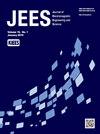一种具有超宽带谐波抑制的双频支路耦合器
IF 1.7
3区 工程技术
Q3 ENGINEERING, ELECTRICAL & ELECTRONIC
Journal of electromagnetic engineering and science
Pub Date : 2023-01-31
DOI:10.26866/jees.2023.1.r.144
引用次数: 0
摘要
提出了一种具有超宽带谐波抑制功能的双频支路耦合器。用π形线代替传统的四分之一波长传输线,实现双波段传输。此外,通过提供三个传输零点的选频耦合结构(FSCS)实现了超宽带谐波抑制。两个工作频率分别为0.9 GHz和2.0 GHz,在0.9 GHz和2.0 GHz下对应的- 10db带宽分别为18.9%和10.5%。在3.7 GHz ~ 8.3 GHz范围内产生较宽的谐波抑制带。仿真结果与实测结果吻合较好。本文章由计算机程序翻译,如有差异,请以英文原文为准。
A Dual-Band Branch-Line Coupler with Ultra-Wideband Harmonic Suppression
A dual-band branch-line coupler with ultra-wideband harmonic suppression is proposed in this paper. The conventional quarter-wavelength transmission lines are replaced with π-shaped lines to achieve a dual band. In addition, ultra-wideband harmonic suppression is obtained by the frequency-selecting coupling structure (FSCS) providing three transmission zeros. The two operating frequencies are 0.9 GHz and 2.0 GHz, and the corresponding -10 dB bandwidth at 0.9 GHz and 2.0 GHz is 18.9% and 10.5%, respectively. A wide harmonic suppression band is generated from 3.7 GHz to 8.3 GHz. The simulation and measurement results are in good agreement.
求助全文
通过发布文献求助,成功后即可免费获取论文全文。
去求助
来源期刊

Journal of electromagnetic engineering and science
ENGINEERING, ELECTRICAL & ELECTRONIC-
CiteScore
2.90
自引率
17.40%
发文量
82
审稿时长
10 weeks
期刊介绍:
The Journal of Electromagnetic Engineering and Science (JEES) is an official English-language journal of the Korean Institute of Electromagnetic and Science (KIEES). This journal was launched in 2001 and has been published quarterly since 2003. It is currently registered with the National Research Foundation of Korea and also indexed in Scopus, CrossRef and EBSCO, DOI/Crossref, Google Scholar and Web of Science Core Collection as Emerging Sources Citation Index(ESCI) Journal. The objective of JEES is to publish academic as well as industrial research results and discoveries in electromagnetic engineering and science. The particular scope of the journal includes electromagnetic field theory and its applications: High frequency components, circuits, and systems, Antennas, smart phones, and radars, Electromagnetic wave environments, Relevant industrial developments.
 求助内容:
求助内容: 应助结果提醒方式:
应助结果提醒方式:


